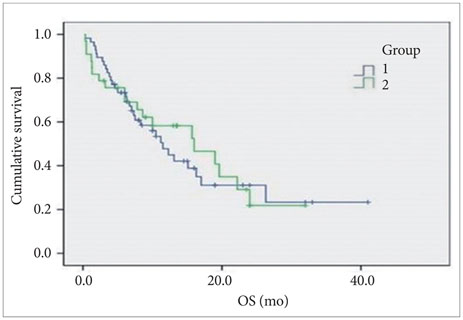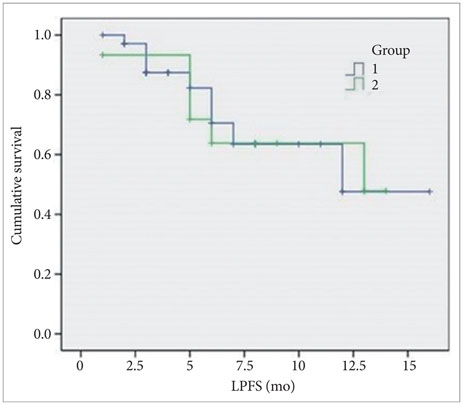Brain Tumor Res Treat.
2015 Oct;3(2):95-102. 10.14791/btrt.2015.3.2.95.
Comparative Analysis of Efficacy and Safety of Multisession Radiosurgery to Single Dose Radiosurgery for Metastatic Brain Tumors
- Affiliations
-
- 1Department of Neurosurgery, Soonchunhyang University Hospital, Seoul, Korea. chosj@schmc.ac.kr
- KMID: 2114654
- DOI: http://doi.org/10.14791/btrt.2015.3.2.95
Abstract
- BACKGROUND
The purpose of this study is to compare the efficacy and safety of multisession radiosurgery to those of single dose radiosurgery for metastatic brain tumors.
METHODS
Between February 2008 and February 2012, 90 patients with 196 metastatic brain tumors were treated with cyberknife radiosurgery, and we reviewed these patients retrospectively. Among them, 57 patients underwent single dose radiosurgery, and 33 patients multisession radiosurgery. Tumors involving the eloquent area and large tumors (>5 cc) were treated with multisession radiosurgery. The median tumor volume and the median treatment dose of single dose radiosurgery were 2.05+/-0.72 cc and 19.76+/-1.54 Gy respectively, and in the case of multisession radiosurgery, 5.30+/-1.70 cc and 29.6+/-1.70 Gy respectively. The frequency of multisession dose was 3 to 5 times, on average 3.55 times, and 8.91 Gy were given per 1 session on average.
RESULTS
The overall survival (OS) of multisession radiosurgery was 16.0 months, whereas that of single dose radiosurgery was 11.5 months. The radiologic tumor response rates were 90% in single dose radiosurgery and 95.4% in multisession radiosurgery, respectively. Over 6-month and 1-year periods, the OS rates of single dose radiosurgery were 71.4% and 44.9%, whereas those of multisession radiosurgery were 69.1% and 58.3%, respectively (p=0.83). Toxicities were seen in 18.1% in the single dose radiosurgery group versus 4% in the multisession radiosurgery group. The difference was significant (p<0.05).
CONCLUSION
In this study, the multisession radiosurgery group, despite the location and size constraints, did not differ from the single dose radiosurgery group when comparing the survival and recurrence rates, but complications and toxicity were lower. Thus, multisession radiosurgery is thought to be beneficial for treatment of large tumors and tumors located in the eloquent area.
Figure
Reference
-
1. Cairncross JG, Kim JH, Posner JB. Radiation therapy for brain metastases. Ann Neurol. 1980; 7:529–541.2. Aoyama H, Shirato H, Tago M, et al. Stereotactic radiosurgery plus whole-brain radiation therapy vs stereotactic radiosurgery alone for treatment of brain metastases: a randomized controlled trial. JAMA. 2006; 295:2483–2491.
Article3. Manning MA, Cardinale RM, Benedict SH, et al. Hypofractionated stereotactic radiotherapy as an alternative to radiosurgery for the treatment of patients with brain metastases. Int J Radiat Oncol Biol Phys. 2000; 47:603–608.
Article4. Andrews DW, Scott CB, Sperduto PW, et al. Whole brain radiation therapy with or without stereotactic radiosurgery boost for patients with one to three brain metastases: phase III results of the RTOG 9508 randomised trial. Lancet. 2004; 363:1665–1672.
Article5. Wowra B, Siebels M, Muacevic A, Kreth FW, Mack A, Hofstetter A. Repeated gamma knife surgery for multiple brain metastases from renal cell carcinoma. J Neurosurg. 2002; 97:785–793.
Article6. Shimamoto S, Inoue T, Shiomi H, et al. CyberKnife stereotactic irradiation for metastatic brain tumors. Radiat Med. 2002; 20:299–304.7. Gaspar L, Scott C, Rotman M, et al. Recursive partitioning analysis (RPA) of prognostic factors in three Radiation Therapy Oncology Group (RTOG) brain metastases trials. Int J Radiat Oncol Biol Phys. 1997; 37:745–751.
Article8. Mintz A, Perry J, Spithoff K, Chambers A, Laperriere N. Management of single brain metastasis: a practice guideline. Curr Oncol. 2007; 14:131–143.
Article9. Muacevic A, Kreth FW, Horstmann GA, et al. Surgery and radiotherapy compared with gamma knife radiosurgery in the treatment of solitary cerebral metastases of small diameter. J Neurosurg. 1999; 91:35–43.
Article10. Muacevic A, Wowra B, Siefert A, Tonn JC, Steiger HJ, Kreth FW. Microsurgery plus whole brain irradiation versus Gamma Knife surgery alone for treatment of single metastases to the brain: a randomized controlled multicentre phase III trial. J Neurooncol. 2008; 87:299–307.
Article11. Vecht CJ, Haaxma-Reiche H, Noordijk EM, et al. Treatment of single brain metastasis: radiotherapy alone or combined with neurosurgery? Ann Neurol. 1993; 33:583–590.
Article12. Nishizaki T, Saito K, Jimi Y, et al. The role of cyberknife radiosurgery/radiotherapy for brain metastases of multiple or large-size tumors. Minim Invasive Neurosurg. 2006; 49:203–209.
Article13. Chang EL, Wefel JS, Maor MH, et al. A pilot study of neurocognitive function in patients with one to three new brain metastases initially treated with stereotactic radiosurgery alone. Neurosurgery. 2007; 60:277–283. discussion 283-4
Article14. Kased N, Binder DK, McDermott MW, et al. Gamma Knife radiosurgery for brain metastases from primary breast cancer. Int J Radiat Oncol Biol Phys. 2009; 75:1132–1140.
Article15. Coughlin C, Scott C, Langer C, Coia L, Curran W, Rubin P. Phase II, two-arm RTOG trial (94-11) of bischloroethyl-nitrosourea plus accelerated hyperfractionated radiotherapy (64.0 or 70.4 Gy) based on tumor volume (> 20 or < or = 20 cm(2), respectively) in the treatment of newly-diagnosed radiosurgery-ineligible glioblastoma multiforme patients. Int J Radiat Oncol Biol Phys. 2000; 48:1351–1358.
Article16. Sturm V, Kober B, Höver KH, et al. Stereotactic percutaneous single dose irradiation of brain metastases with a linear accelerator. Int J Radiat Oncol Biol Phys. 1987; 13:279–282.
Article17. Muacevic A, Kreth FW, Mack A, Tonn JC, Wowra B. Stereotactic radiosurgery without radiation therapy providing high local tumor control of multiple brain metastases from renal cell carcinoma. Minim Invasive Neurosurg. 2004; 47:203–208.
Article18. Wang ZZ, Yuan ZY, Zhang WC, You JQ, Wang P. Brain metastasis treated with Cyberknife. Chin Med J (Engl). 2009; 122:1847–1850.19. Ernst-Stecken A, Ganslandt O, Lambrecht U, Sauer R, Grabenbauer G. Phase II trial of hypofractionated stereotactic radiotherapy for brain metastases: results and toxicity. Radiother Oncol. 2006; 81:18–24.
Article20. Aoyama H, Shirato H, Onimaru R, et al. Hypofractionated stereotactic radiotherapy alone without whole-brain irradiation for patients with solitary and oligo brain metastasis using noninvasive fixation of the skull. Int J Radiat Oncol Biol Phys. 2003; 56:793–800.
Article21. Stafinski T, Jhangri GS, Yan E, Menon D. Effectiveness of stereotactic radiosurgery alone or in combination with whole brain radiotherapy compared to conventional surgery and/or whole brain radiotherapy for the treatment of one or more brain metastases: a systematic review and meta-analysis. Cancer Treat Rev. 2006; 32:203–213.
Article
- Full Text Links
- Actions
-
Cited
- CITED
-
- Close
- Share
- Similar articles
-
- Preliminary Report of Multisession Gamma Knife Radiosurgery for Benign Perioptic Lesions: Visual Outcome in 22 Patients
- Stereotactic radiosurgery for brain metastases
- Gamma Knife Radiosurgery for Single & Multiple brain Metastasis
- How to use Leksell GammaPlan
- LINAC Radiosurgery for Metastatic Brain Tumors



